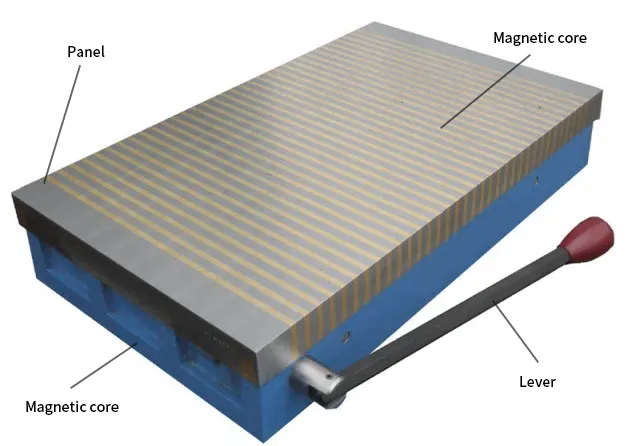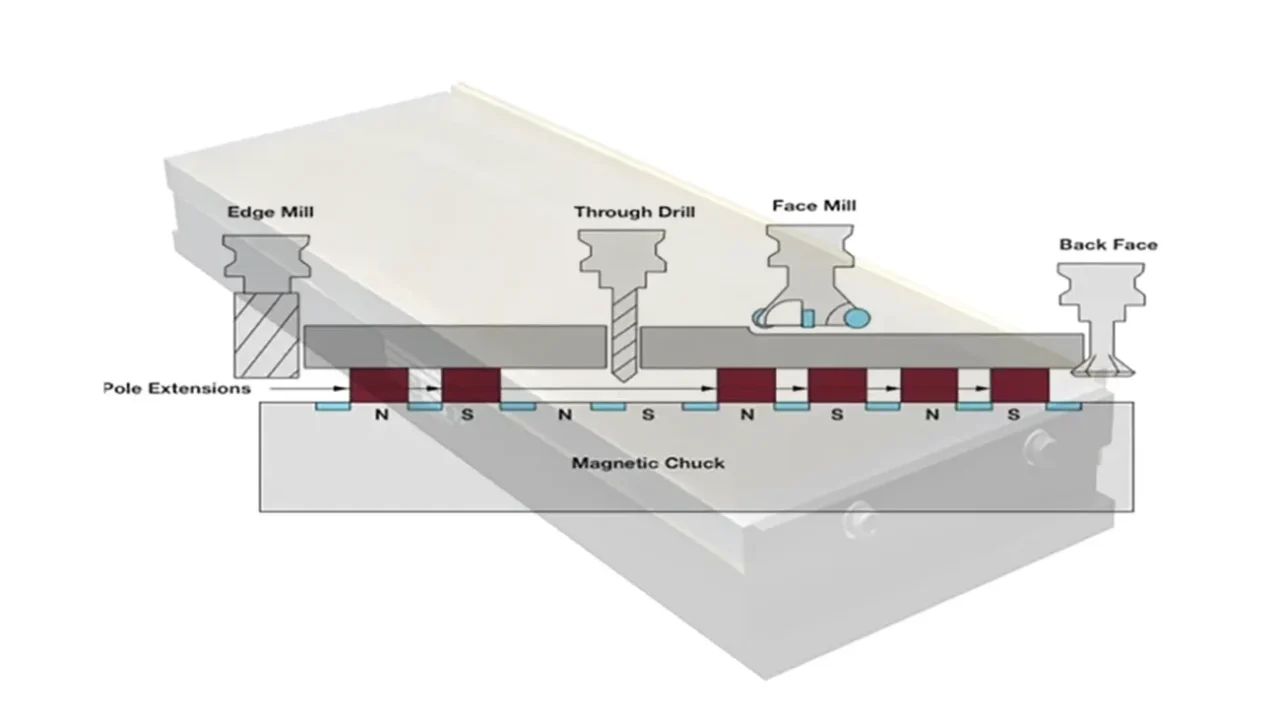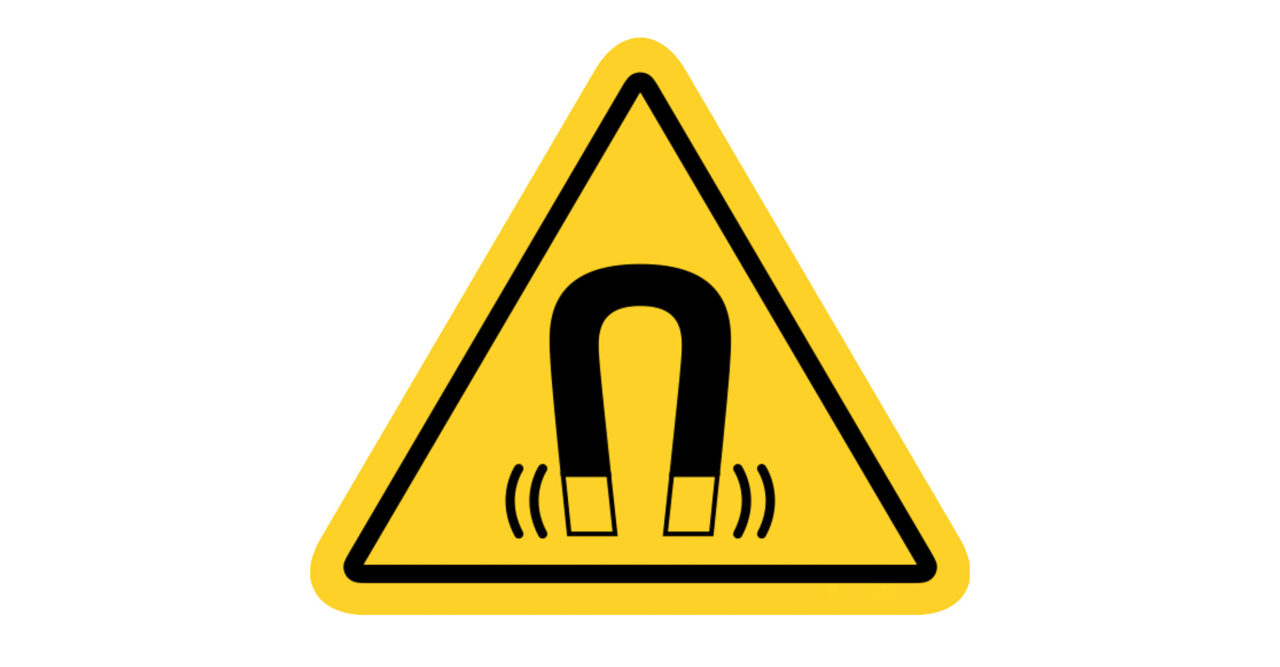Through the previous article on magnetic chuck types, we have learned about the working principles and characteristics of different magnetic chucks. But do you know what structures and materials these magnetic chucks are made of? Come and follow me as I dissect and analyze it.
Structural Composition of Magnetic Chuck.
It is as important for us to have a clear understanding of the construction of the magnetic chuck as it is the type of chuck. When looking at a magnetic chuck, we can only see its surface, and the real power comes from the inside. The internal structure determines the holding force, durability, precision and ease of use of the magnetic chuck. Now that you have decided to buy a magnetic chuck, you must have some understanding of its internal structure, otherwise you may buy a model that has poor performance or does not meet expectations.

Lever (control system):
The lever or control system is the physical interface through which the user activates and deactivates the chuck. There is a simple manual lever on the permanent magnet chuck. Rotating the lever can align or stagger the internal permanent magnets, and changing their arrangement can lock or release the workpiece.
The electromagnetic chuck does not have this small tail (lever), but is replaced by an electrical control unit. The magnet is controlled by an external electrical system and can be integrated with CNC systems for precise power adjustment. But this also leads to the above-mentioned problem of “the retention force will disappear when the power is cut off”.
In order to avoid the risk of power outages, the electric permanent magnetic chuck was born. Its control system only needs to generate pulse current to magnetize or demagnetize the sucker when switching states, ensuring the safety of the workpiece even if the power is cut off.
Panel:
The top plate is the working surface where the workpiece is placed for all processing operations. It looks like a solid steel plate, but is actually a carefully designed grid of magnetic pole channels made of magnetic conductors that guide magnetic energy to secure the workpiece. Magnetic pole configuration (number and width) varies depending on the purpose of the chuck. If you want to hold small, thin parts, you need a fine-pole chuck. When facing large and heavy metal blocks, the standard magnetic pole chuck can provide deeper and more stable magnetic penetration. (You can learn more about the magnetic pole design of the chuck in another blog). It should be noted that the panel material of the electromagnetic chuck needs to be composed of insulators and magnetic conductors, and its array method is consistent with the internal permanent magnet array method.
Magnetic core:
As the true power source of magnetic chucks, the magnetic cores vary from chuck to chuck.
Permanent magnet chucks rely on high-grade permanent magnets (neodymium or cobalt magnets) carefully arranged in alternating polarities to produce a continuous magnetic field. The material of the permanent magnet determines the strength and lifespan.
Electromagnetic chucks use copper coils wrapped around a steel core – when current flows through them, a strong magnetic field is created.
Electromagnetic chucks combine permanent magnets with an electrically activated system, with the magnets arranged in a specific pattern (parallel, concentric or radial) beneath the panel. Once a magnetic field is established with the addition of an electromagnetic pulse, no additional electricity is required to maintain it.
Protective housing:
The outer, bottommost metal housing is used to protect all these internal components (magnetic core, faceplate and switch mechanism) from coolant, metal shavings and physical damage. The housing is usually made of steel or aluminum and its shape depends on the shape of the magnetic chuck.
For electromagnetic chucks, ventilation slots or cooling systems can be integrated into the housing to dissipate heat. During the production process, we will also add a layer of protective coating such as nickel or epoxy resin to the shell according to the customer’s workshop environment.
Additional functional components:
To accommodate specific machining needs, some chucks also include T-slots or other mechanical clamping options in the faceplate, providing greater flexibility in the machining process. In order to deal with situations where special bevel angle processing is required, a sine table can also be added to the bottom shell of the chuck.
A magnetic chuck is more than just a simple three-dimensional metal block. Every detail of its internal structure determines its performance and use.
What Materials Are Used in Magnetic Chuck Construction?
If you really want to choose a reliable magnetic chuck, then you need to look beyond the construction of the chuck to the materials used for its structural components. Because its material directly affects durability, holding power and performance under processing conditions.
Let’s start with the surface plate, the working area where the material is placed. Most manufacturers use high-quality steel or steel alloys, chosen for their hardness, wear resistance, and ability to efficiently transmit magnetic forces. Some chucks use hardened tool steel plates to withstand the repeated impacts of heavy workpieces, while others use nickel plating or a corrosion-resistant surface to prevent rust in environments with heavy coolant content. If you are involved in precision machining, finely ground steel plates ensure a perfectly flat surface, thus avoiding distortion of the workpiece.
Beneath the surface, the magnetic core is the component that creates the actual holding force. Material selection here varies depending on the chuck type. Permanent Magnetic Chucks rely on neodymium (NdFeB) or ceramic (ferrite) magnets bonded to steel at a specific pole distance. Neodymium provides the strongest holding force, ceramic provides better resistance to heat and demagnetization. Electromagnetic chucks, on the other hand, use a coil of copper wire wrapped around a laminated steel core to create a magnetic field when powered.
On the underside of the chuck, the housing and frame need to provide structural integrity protection. Our production shops typically use cast iron or hardened steel to ensure the chuck remains rigid under high-pressure machining. Cast iron absorbs vibration well, reducing chatter during cutting, while steel offers excellent impact resistance.If a customer’s chuck needs to be exposed to high humidity or corrosive coolants, we also offer nickel-plated, nickel-plated, or epoxy-coated housings to prevent corrosion and extend service life.
Each material within a magnetic chuck has a specific role, and they work together to provide the best balance of strength, durability, and efficiency. If you’re looking for a durable chuck cup, pay attention to these material choices – they have a big impact on actual performance.
Proper magnetic chuck construction ensures better machining accuracy, longer tool life and safer operation. Don’t let an improperly selected chuck slow down your production or cause unnecessary downtime. If you are still not confident in your decision, please contact our customer service. We will help you match the appropriate chuck according to your needs from a professional perspective.
FAQs
What factors affect the holding force of magnetic chucks?
Surface contact, workpiece material type, and work environment are important in achieving maximum holding power from a magnetic chuck. Clean and flat workpieces ensure maximum contact and grip. High carbon steel can achieve better adsorption on magnetic chucks than low carbon steel. Normal temperature and an environment without electromagnetic interference are the favorites of magnetic chucks.
Why does my magnetic chuck lose strength over time?
Dirt accumulation, surface wear or demagnetization can weaken the performance of the chuck. Regular cleaning and surface regrinding can restore adsorption performance to a certain extent. Magnetic chucks can lose magnetic attraction due to wiring issues. If the holding force is weakened suddenly, check for mechanical wear or electrical faults.





